Helicopter
![]()
Helicopter is a redirect to this article. For other meanings, see Helicopter (disambiguation).
A helicopter is a vertical take-off and landing aircraft that transmits engine power to one or more nearly horizontal rotors for lift and propulsion. These operate as spinning airfoils or wings. Helicopters are thus classed as rotary-wing aircraft and are by far the most important representatives of this large group of aircraft. "Rotorcraft" is also the appropriate translation of the word helicopter, or heli for short, which is composed of Ancient Greek ἕλιξ hélix (Gen. ἕλικος hélikos) "coil, spiral, screw" and πτερόν pterón "wing". The words helicopter and helicopter are synonymous. Colloquially, helicopter is gaining acceptance in German-speaking countries (cf. also helicopter parents),. Officially, however, both words are used in Switzerland.
The delineation of the term helicopter is variable. In the broadest sense, helicopters and rotorcraft are treated as synonyms. Typically, however, rotorcraft without a powered main rotor, such as gyroplanes with their own propulsion rotors, are not counted as helicopters. Helicopters that combine the characteristics of these two aircraft are classified inconsistently with helicopters. Helicopters that also have rigid wings are called compound helicopters. Convertible aircraft do not count as helicopters.
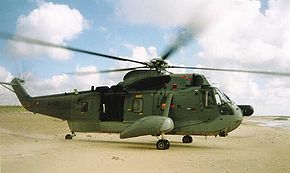
Sikorsky S-61 Sea King naval helicopter
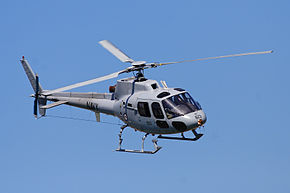
Eurocopter AS350BA of the Fleet Air Arm of the Royal Australian Navy
History
The principle of lift in the form of a spiral was already known to the ancient Chinese, who had used it 2500 years ago in the toy "flying top". Leonardo da Vinci had made sketches of a helicopter in his "Paris Manuscripts" around 1487-1490, but it was not until the 20th century that the technical implementation of this idea was achieved. Pioneers of helicopter development included Jakob Degen, Étienne Œhmichen, Raúl Pateras Pescara, Oszkár Asbóth, Juan de la Cierva, Engelbert Zaschka, Louis Charles Breguet, Alberto Santos Dumont, Henrich Focke, Anton Flettner and Igor Sikorski.
Beginnings
As early as the 14th century, a toy called the "Chinese aerial gyroscope" was known in Europe, which is still manufactured today in a modified form. It was a rotor-like structure made of bird feathers, which, when set in rotation, could rise vertically into the air like a helicopter. Leonardo da Vinci studied the helicopter in the 15th century and drew a flying machine that was to be propelled in the manner of the Archimedean water screw. In 1768, French mathematician Alexis-Jean-Pierre Paucton designed the first concept, called a pterophore, for a muscle-powered helicopter with two separate rotors responsible for lift and propulsion. In 1783, the French naturalist Christian de Launoy and his mechanic Bienvenu built a coaxial version of the Chinese aerial gyro. A similar design was created by the British engineer George Cayley.
In the 18th and 19th centuries, there were a variety of ideas for helicopter-like flying machines. For example, Mikhail Lomonosov designed a helicopter model with coaxial rotors to explore the atmosphere. The Austrian master watchmaker Jakob Degen also experimented with coaxial models, using a clockwork as a propulsion system. Around 1825, Englishman David Mayer built a muscle-powered helicopter, and in 1828, Italian Vittorio Sarti designed a helicopter with two three-bladed propellers. In 1842, the American Robert Taylor completed his design for collective pitch and offered it to the aviation pioneer Sir George Cayley. Cayley adopted Taylor's concept for a flying machine with two side-mounted coaxial rotors and two propellers for propulsion. A steam engine was to serve as propulsion, but it proved too heavy and doomed the project to failure. In 1861 Gustave de Ponton d'Amecourt was granted a patent for a coaxial rotor design. Both were obviously aware of the need for torque balance, which they addressed by using two counter-rotating main rotors. In 1869, the Russian engineer Alexander Nikolayevich Lodygin submitted to the War Ministry a concept of a helicopter powered by an electric motor. The model was already equipped with a main rotor and a tail rotor. Around 1870, Alphonse Pénaud built coaxial helicopters with rubber-band propulsion as children's toys. One of his toy airplanes is said to have inspired the Wright brothers. In 1874, Fritz and Wilhelm von Achenbach sketch a rotorcraft with a main and tail rotor (the most common helicopter configuration today) that would be powered by a steam engine. In 1877, the Italian Enrico Forlanini built a small unmanned 3.5 kg helicopter with steam propulsion and two coaxial counter-rotating rotors. In the summer of that year, he demonstrated this flying machine in a public park in Milan, flying for about 20 seconds and 13 meters high. Thomas Edison also built a helicopter in 1885, commissioned by James Gordon Bennett Jr, but it failed to take off due to excessive weight. Around 1890, Wilhelm Kress built a flying machine with coaxial rotors and determined the relationship between rotor diameter, power and lift.
In 1901, the first flight of a helicopter by Hermann Ganswindt took place in Berlin-Schöneberg. Since there were no sufficiently powerful engines yet, Ganswindt used a drop weight that also drove the rotor via a rope. The helicopter flew for only a few seconds, but it took off with two people on board. A film by the Skladanowsky brothers of the event is lost. Because Ganswindt had attached a safety bar, he was therefore accused of fraud in 1902 and remanded in custody for eight weeks. In the same year, a helicopter designed by Ján Bahýľ also reached a flight altitude of 50 cm.
On November 13, 1907, Paul Cornu lifted his 260 kg flying bicycle 30 cm vertically off the ground for 20 seconds. He used tandem rotors powered by a 24 hp V8 engine. This was the first documented free manned vertical flight, although the flight is doubted due to low engine power. That same year, brothers Louis Charles and Jacques Bréguet, in collaboration with Professor Charles Richet, also built Gyroplane No. 1 with four counter-rotating rotors, 45 hp petrol engine and 580 kg take-off mass, but it could only fly vertically upwards.
In 1909, Vladimir Valeryanovich von Tatarinoff, with the support of the Russian War Ministry, built the Tatarinov Aeromobile, which had a car-like shape with a front propeller and four lifting propellers mounted above the vehicle. The unpromising design was destroyed by the designer after public criticism.
From 1910 Boris Nikolaevich Yuriev solved some basic theoretical-constructive problems of stability and propulsion and developed the swashplate.
In 1913, the Dresden engineer Otto Baumgärtel designed a vertical take-off aircraft that could move forward without a special propeller by shifting the centre of gravity.
In 1916 the Dane Jacob Christian Hansen Ellehammer built a helicopter with coaxial rotors and a nose propeller, a self-designed 6-cylinder radial engine with 36 hp and the first use of collective and cyclic pitch control. The Italian Gaetano Arturo Crocco had proposed this technique in 1906. Ellehammer is thus the inventor of the rotor control system commonly used today. After the crash and the destruction of the machine he gave up the development. Again a coaxial rotor was built by the Rüb brothers in Stuttgart in 1917, but it could not take off due to lack of propulsion power.
Towards the end of the First World War, the designers Stephan Petróczy von Petrócz, Theodore von Kármán and Wilhelm Zurovec carried out successful flight tests with the PKZ-1 and PKZ-2, named after them, on behalf of the Imperial and Royal Army. The PKZ-1 and PKZ-2, named after them, were successfully tested by the Imperial and Royal Army. Such vertically ascending aircraft were intended to replace the tethered balloons that had been common until then for observing the enemy. The PKZ-2 with coaxial rotor and three engines with 120 hp each reached a flight altitude of about 50 m, which was a record at that time. During a demonstration flight on June 10, 1918 in Fischamend, the machine crashed. The end of the war prevented further development.
In the years 1919 to 1922 Henry A. Berliner constructed helicopters in the USA with coaxial as well as with side-by-side rotors. With both he undertook free hovering flights of short duration.
On November 11, 1922, Étienne Œhmichen first launched his Œhmichen No. 2, the first documented and reliably flying man-portable vertical take-off aircraft, a quadrocopter.
During the development of his autogiro in 1923, Juan de la Cierva (Spain) came up with essential solutions for stabilizing the rotor of a rotorcraft, such as the flapping joints. This concept had been patented in the German Reich Patent No. 249702 from 1912 by Max Bartha and Josef Madzsar in connection with the head-tilt control for a coaxial rotor. In the same year, the largest helicopter in the world at the time, developed by George de Bothezat, flew in the USA with four rotors on booms and two additional smaller control rotors. It had a take-off mass of 1600 kg and was powered by a 220 HP engine.
On 18 April 1924, Pescara No. 3, developed by Raúl Pateras Pescara, doubled the world record for rotorcraft set four days earlier by Œhmichen, using cyclic pitch for the first time to use the main rotor for propulsion. Œhmichen's helicopter had four adjustable main rotors, five propellers for stabilization, two propellers for propulsion, one propeller for control, and a 180-hp Gnôme engine for propulsion. Despite the first two officially recognized "world records" for helicopters, these complicated machines were a technical dead end.
In Germany, chief engineer Engelbert Zaschka developed a combined hydrofoil and helicopter in 1927. In Zaschka's development, in contrast to the hydrofoils and helicopters known up to that time, the rotors of the Zaschka rotary aircraft were connected in a forcibly rotating manner with a flywheel mass effective through two gyroscopes. Accordingly, the helicopter model had a balance control by a gyroscopic mass (kinetic energy). This arrangement made it possible to perform a safe vertical glide with the engine switched off.
From 1925, the Dutchman A.G. von Baumhauer attempted to implement the rotor arrangement commonly used today, with one main rotor and one tail rotor. His helicopter had a main rotor with a diameter of about 15 m, which was driven by a 200 hp engine. To drive the tail rotor, he used a separate 80 hp engine. The first flight took place in 1930, but development was halted after a main rotor blade broke. In the same year, the Belgian Nicholas Florine and the Italian Corradino D'Ascanio successfully tested their helicopters. Nicholas Florine's machine had a tandem rotor arrangement with two four-blade rotors of 7.2 m diameter and weighed about 950 kg. It was powered by a 220-horsepower Hispano-Suiza engine and allowed hover flights of up to ten minutes. The helicopter designed by D'Ascanio, with coaxial rotors and three adjustable auxiliary propellers, flew up to 1078 m, reached an altitude of 18 m and a flight duration of nine minutes. Also in 1930, Raoul Hafner built a helicopter in Austria with Bruno Nagler. Although this even had a swash plate, control problems led to the abortion of the tests.
Between 1930 and 1935 Oszkár Asbóth in Hungary and Walter Rieseler in Germany experimented with helicopters with coaxial rotors, in which the controllability was to be improved with tailplanes in the rotor downwind.
In 1932, under the direction of Boris Nikolajewitsch Jurjew, the ZAGI 1-EA was developed in the Soviet Union with a main rotor and two control rotors each at the nose and tail. This had a take-off mass of 1200 kg and two engines with 120 hp each.
The rest of the 20th century
In the early 1930s, Louis Charles Breguet and René Dorand built the Gyroplane-Laboratoire, the first helicopter to fly stably for any length of time. It had coaxial rotors and held all international records for helicopters from June 1935.
The Focke-Wulf Fw 61, which used two laterally arranged rotors, was able to break a number of previous world records for helicopters during its maiden flight in June 1936. It was also the first helicopter to successfully perform an autorotation landing.
In the USA, the Sikorsky VS-300, which made its maiden flight in 1939, was the first practical helicopter. This prototype became the model for the Sikorsky R-4, which went into series production in 1942.
In 1941, the German Focke-Achgelis Fa 223 was the first helicopter built in series, also with two side-mounted rotors. This was followed in 1943 by the Flettner Fl 282, also with twin rotors, and in 1944 by the Sikorsky R-4 "Hoverfly" in the USA, which like its predecessor Sikorsky VS-300 used a single rotor together with a tail rotor.
In 1943, the Doblhoff WNF 342 was the first experimental helicopter to use hot blade tip propulsion. The PV-1, also designed by Frank Piasecki and Harold Venzie in 1943, had a design without a tail rotor, similar to today's NOTAR technology. However, work on this was soon abandoned in favor of a tail rotor design.
On March 8, 1946, Bell Aircraft Corporation's Bell 47, a light two- or three-seat helicopter based on a design by Arthur M. Young, became the first civilian helicopter to receive flight certification in the United States. Its variants were found worldwide into the 1980s and beyond.
On the Soviet side, the Mil Mi-1, developed by Mikhail Mil, was the first mass-produced helicopter, with the GM-1 prototype flying for the first time in September 1948.
In 1955, the French company Sud Aviation equipped its Alouette II helicopter with a 250-kW Turbomeca Artouste shaft turbine, thus building the first gas turbine-powered helicopter, which is used today by almost all commercial manufacturers. Only Robinson Helicopter (Robinson R22 and Robinson R44), Brantly (Brantly B-2 and Brantly 305 respectively) and Sikorsky (Schweizer 300C) still produce helicopters with piston engines.
The most widely built helicopter family, the Bell 204 - militarily called Bell UH-1 - with 16,000 units to date, took off on its maiden flight on 22 October 1956.
In 1967, the German Bölkow Bo 105 was the first helicopter to be equipped with a hingeless rotor head together with GRP rotor blades, which had first been used on the Kamow Ka-26. The Eurocopter EC 135 as the current successor uses a further developed form, the so-called hingeless and bearingless rotor head. There, the bearings for the blade angle adjustment were also replaced by a drill control element consisting of glass-fibre reinforcedplastic with a control bag.
In 1968, the Soviet Mil Mi-12, the largest helicopter ever built, took off. It has side-by-side rotors, a maximum take-off weight of 105 t with a maximum payload of 40 t and 196 passenger seats. After three prototypes, which achieved a number of records, production was discontinued.
In 1975, the light and inexpensive Robinson R22, which went into mass production in 1979, took off on its maiden flight.
1977 saw the maiden flight of the largest series-produced helicopter, the Mil Mi-26, which is still in production and service today.
Starting in 1980, the Kamow Ka-50 "Hokum" was developed as the first helicopter equipped with an ejection seat. Together with its further development, the Kamow Ka-52 Alligator, it is the only helicopter that has been equipped with an ejection seat so far. The rotor blades are automatically jettisoned when the ejection seat is activated.
Starting in 1983, the Boeing-Sikorsky RAH-66 Comanche, a combat helicopter with stealth technology, was developed, but its production was stopped shortly before it reached operational readiness in 2004 due to escalating costs.
In 1984, the Sikorsky X-wing flew for the first time, its rotor being stopped and locked in forward flight and then serving as an additional wing. As with other VTOL concepts, this was intended to achieve better flight performance than pure rotorcraft. However, it remained a prototype.
In 1989, Da Vinci III was the first muscle-powered helicopter to take off from the ground for a few seconds - up to 20 cm high, by pedal crank and single rotor, in California.
· 
Œhmichen No. 2, 1922
· 
Test model of the Zaschka rotary wing aircraft, July 1928
· 
Coaxial helicopter Gyroplane-Laboratoire from 1935
·
Focke-Wulf Fw 61, 1936, with which the first autorotation landing succeeded
· 
Focke-Achgelis Fa 223, the first helicopter built in series production
· 
Bell 47, the first helicopter with civil certification in the USA
·
Bell UH1-D/Bell 204, most built helicopter family
· .jpg)
BO 105 CBS-5, first helicopter with a hingeless rotor head
21st century
In August 2008, the Sikorsky X2 proved in its maiden flight the suitability of the coaxial rotor optimized with the latest processes in combination with a pusher propeller - the principle of the earlier gyrocopters. Two years later, it reached its development target of 250 knots true airspeed (463 km/h), beating the previous speed record by 15 %. Other manufacturers also tested similar new high-speed designs, including Eurocopter's X³ and Kamow's Ka-92.
In October 2011, the world's first manned flight with a purely electrically powered helicopter took place with the Volocopter.
In 2011/2012/2013, different teams in the USA improved performances with 3 prototypes (Gamera (I), Gamera II and AeroVelo Atlas) of muscle-power quadrocopters for one person, indoors. Most recently, Atlas achieved 64 seconds flight duration, 3.3 m maximum altitude, and less than 10 m drift, winning the Sikorsky award.
·
Mil Mi-12, largest helicopter in the world
· 
Mil Mi-26, largest helicopter in series production
· 
Boeing-Sikorsky RAH-66 "Comanche", prototype of the combat helicopter with stealth technology
· 
Eurocopter X3, high-speed helicopter, ILA 2012 (world record)
· 
Maiden flight of the Volocopter type VC 1 in October 2011
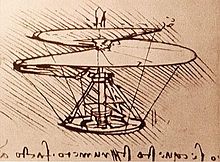
Early design of a "flying screw" by Leonardo da Vinci

Experimental helicopter by Enrico Forlanini (1877), exhibited at the Museo nazionale della scienza e della tecnologia Leonardo da Vinci Milan
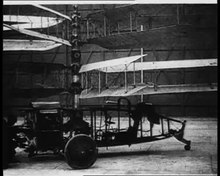
Play media file Test flight of a helicopter by Raúl Pateras-Pescara at Issy-les-Moulineaux airfield, Paris (1922)
Function
The rotating rotor blades generate dynamic lift from the incoming air. As with the rigid wings of an aircraft, this depends, among other things, on their profile, the angle of attack and the inflow velocity of the air (which is not constant over the blade length), see main rotor.
When a helicopter moves forward, the inflow velocity changes, because the orbital velocity and the airspeed of the blade moving forward are added. When the blade is moving backwards, they subtract each other, see also the sketch below.
Due to the aerodynamics of the rotor blades, asymmetrical forces are generated on the blades moving forwards and backwards during flight, which in older models had to be absorbed by flapping and pivoting joints on the attachment, the rotor head. Newer designs do without these joints. In these newer models, the rotor head and blades are made of a composite of materials of different elasticity (elastomers as well as high-strength and lightweight metals such as titanium), which can cope with the constantly changing dynamic forces in terms of size and direction without damaging the components. Such a hingeless rotor head was first realized on the Bölkow Bo 105 using blades made of glass-fiber reinforced plastic and a solid rotor head made of titanium in combination with elastomers. On the Eurocopter EC 135, this was further developed into a bearingless rotor head, which has become the standard on most models.
Blade pitch
The cyclic (also rotation periodic) blade pitch control - commonly called blade control - is used to control the horizontal movement of the helicopter, which requires an inclination of the main rotor plane. To initiate or terminate forward, reverse or sideways flight, the pitch angles of the blades are changed (cyclically) as the rotor rotates. This results in a cyclic flapping motion of the blades so that their blade tips orbit on a plane that slopes in the intended direction. The lift remains constant throughout the orbit. Accordingly, the rotor thrust that supports and propels the helicopter is at right angles to the blade tip plane. The force that lifts purely vertically in hover flight now receives a forward propulsive thrust due to this inclination. Due to the fuselage drag, the entire helicopter and thus its rotor shaft also inclines in the direction of flight.
If the centre of gravity of the helicopter (when suitably loaded) is in extension of the rotor shaft, the thrust will pass through the centre of gravity at any constant speed. The blade tip plane is then at right angles to the rotor shaft and flapping movements do not occur. It only exists at other C.G. positions or when the airspeed is to be changed.
With the collective pitch control, the pilot changes the angle of attack of all rotor blades evenly, which causes the helicopter to climb or descend. Simple designs, for example in various electric drives in model helicopters, replace this control by a speed change. The disadvantage is the longer reaction time due to the inertia of the main rotor.
The rotor blades are usually controlled by a swashplate. Its lower, fixed part is moved up or down by the pilot with the help of the "collective" adjustment lever. With the "cyclic" control stick, this in turn can be tilted in any direction. The upper part of the swashplate (which rotates with the rotor) transfers the desired setting angle to the rotor blades via pushrods and levers at the blade roots.
Rotor variants and yaw moment compensation
A distinction is made between single rotor systems, double rotors, triple rotors and machines with four (quadrocopter) or more rotors. With the exception of the blade tip drive, the rotors are always driven by a motor in the fuselage. This creates a counter-torque (yaw moment) at the rotor axis, which would cause the fuselage to rotate in the opposite direction with a single rotor. To compensate for this, various constructions are used:
Single rotor system
Generation of a lateral counter-thrust by a tail rotor, also encapsulated as a shrouded propeller with the Fenestron, or by thrust nozzles with the NO-TAil-Rotor-(NOTAR)-System
· 
Tail rotor of a Super Puma
· 
Fenestron on an EC 120
Dual rotor systems
Two counter-rotating main rotors whose yaw moments balance each other out - by being arranged one above the other on the same axis (coaxial rotor), one behind the other (tandem configuration) or side by side (transverse). Another variant is the intermeshing rotors with the rotational axes of the Flettner twin rotor placed close together and at an angle to each other. In the Sikorsky X2, the coaxial design also allows higher speeds in combination with a pusher propeller, as first used in the Fairey Gyrodyne in 1947.
· 
Coaxial helicopter KA-27 of the Russian Navy
·
Transversal configuration of the Focke-Wulf Fw 61
· 
Kaman K-1200 K-Max with counter-rotating Flettner double rotor from the front
· 
Chinook of the Royal Air Force with double rotor in tandem configuration
Triple rotor systems
Only rarely (Cierva W.11), in planning (Mil Mi-32) or in model making (Tribelle, Tricopter) triple rotors appeared, where the torque is compensated by slightly tilting the rotor vertical axes or even by tilting one of the rotors.
· 
Cierva W.11 with three main rotors
Quadro and Multicopter
The quadrocopter uses four rotors in one plane and allows control around all three axes solely through linked adjustment of pitch or speed. Common is square arrangement, necessary is opposite turning sense of neighbouring rotors. Based on this technology, designs with six, eight, twelve or more (e.g. Volocopter with 16 or 18) rotors are also used.
· 
The Curtiss-Wright VZ-7 quadrocopter...
· 
The AirRobot AR 100-B
Blade tip drive
With blade tip drive, the rotor is driven by the recoil of a propeller or gas jet, so that no counter-torque acts on the fuselage.
A system with two rotors is technically the more efficient design, since all rotors are used for lift and propulsion, while the tail rotor costs about 15 % of the total power in hovering flight. In practice, however, the single rotor system with one tail rotor has largely prevailed. Economically, the lower construction and maintenance costs of only one rotor head and one gearbox are more important, since these are the two most complex and sensitive assemblies of a helicopter.
Tail rotors are available in designs with two to five blades. To reduce noise, four-bladed X-shaped rotors are sometimes used. A particularly quiet variant is the Fenestron, a shrouded propeller in the tail boom with up to 18 blades.
In most cases the tail rotor is driven from the main gearbox via shafts and reversing gears, so that its speed is always proportional to that of the main rotor. The thrust for control around the yaw axis is regulated by the pilot with the pedals via the setting angle of the tail rotor blades analogous to the collective adjustment of the main rotor.
During cruise flight, many designs relieve the tail rotor by having a fin largely compensate for the yaw moment. This is usually realized by end discs on the horizontal damping surface, which are set at an angle to the longitudinal axis of the fuselage, and in the case of a single fin usually additionally by an asymmetric airfoil.
Emergency control and autorotation
Should the drive fail, helicopters can still land unharmed. To do this, the pilot must enter a steep descent, whereby the freewheeling rotor is kept in rotation or accelerated as much as possible by the air now flowing upwards from below, in order to maintain or increase the angular momentum. This resulting autorotation, as in the gyroplane, provides the lift limiting the rate of descent and assists the helicopter in maintaining an upright position. A yaw moment compensation is not necessary, because only the small moment from the bearing friction (in the main rotor head, gearbox and drive) would have to be compensated, but this does not lead to a critical increase of the yaw rate until landing. Such a landing is therefore possible even if the tail rotor fails, e.g. if the drive shaft for the tail rotor, the angular gear to the tail rotor or even the entire tail boom breaks. More critical, however, is reaching a suitable place for this emergency landing.
Shortly before reaching the ground, the collective angle of attack is increased from slightly negative to positive in order to significantly increase lift. This slows down the descent with the aim of a halfway gentle and safe touchdown for technology and crew, and the rotor rotation is reduced. The rotor's angular momentum decreases in the process, its energy is dissipated, so there is only one attempt at this delicate manoeuvre. However, the loss of control around the vertical axis and the need to hit the exact moment makes this manoeuvre always risky.
A minimum altitude above ground is required for the emergency landing, as a sag is unavoidable in the event of main engine failure and time is also required to transition to the new flight attitude.
Emergency landing with autorotation must be practiced regularly by pilots.
Control
A helicopter is not an inherently stable aircraft - it always has the tendency, especially in hovering and slow flight, to leave its flight attitude and to push, tilt or turn in one direction or the other. One of the reasons for this is that the neutral point is above the fuselage and therefore above the centre of gravity. The pilot must intercept these movements by continuous, counteracting control inputs. At a flying speed above approx. 100 km/h, a helicopter behaves similarly to a winged aircraft and is correspondingly easy to control. Landing is particularly dangerous, as there are not enough reserves to go into autorotation if the engine fails at too low an altitude. When touching the ground, the so-called ground resonance can occur, which can very quickly lead to the destruction of the helicopter.
Unlike in fixed-wing aircraft, the pilot of a helicopter usually sits on the right side. He needs both hands and feet for steering:
- With his left hand he controls the collective pitch by means of a lever. This involves pushing the swashplate straight up or down over the rotor axis, thus changing the angle of attack of all rotor blades of the main rotor to the same extent and thus increasing or decreasing the lift of the rotor. This causes the helicopter to rise or fall. In order to prevent the rotor speed from dropping due to the resulting increase in drag when the angle of attack of the main rotor blades is increased, the engine or turbine power is also increased via this lever. This is done either manually with a rotary handle on the lever or automatically. By changing the engine or turbine power, the generated torque is also changed, which makes countersteering via the tail rotor necessary.
- With the right hand, the pilot controls the cyclic blade pitch via the control stick (in the photo above the S-shaped stick centered in front of the pilot's seat). This tilts the swashplate and changes the rotor plane accordingly, initiating the movement of the helicopter around the longitudinal (roll to the left or right) and lateral axis (pitch forward or backward). The control commands given to the rotor head with the control stick via the swashplate also allow combinations of pitch and roll movements.
- On the cockpit floor there are two pedals which control the angle of attack of the tail rotor and thus the movement of the helicopter around the yaw axis (vertical axis), i.e. the rotation to the right or left.
Flight performance
In principle, helicopters do not achieve the (forward) flight performance of fixed-wing aircraft: the maximum speed is usually between 200 and 300 km/h, with some combat helicopters reaching over 360 km/h. The speed record is 472 km/h and was achieved on 7 June 2013 with a Eurocopter X³.
The maximum speed is limited by the aerodynamics of the rotor blades: The forward moving blade has a higher speed than the rearward moving blade in relation to the air flowing in from the front. If the forward blade approaches the speed of sound in the outer area, there is a drop in lift, a sharp increase in drag and high blade stress due to torsional moments. This manifests itself, for example, in strong oscillations and thus makes it difficult for the pilot to control the helicopter.
For a typical rotor diameter of 10 m, this means that the rotor cannot perform more than approx. 11 revolutions per second (which is 660 revolutions per minute) without exceeding the speed of sound (approx. 343 m/s at 20 °C) in the outer areas of the rotor blades. Typical rotor speeds in operation are therefore well below this value.
Often, however, the speed of a helicopter is limited by the returning rotor blade: Here the combination of high angle of attack (cyclic adjustment, see above) and low airspeed leads to stall and thus loss of lift. Many helicopters therefore tip first to the side where the rotor blades are turning backwards when reaching critical speed, before the forward turning blades enter the supersonic range.
The summit altitude is also limited and is typically around 5,000 metres, with individual models reaching up to 9,000 metres. The FAI altitude record of 12,442 metres was set in June 1972 by Jean Boulet in an Aérospatiale SA-315. It was not surpassed until March 2002 by a flight by Fred North in a Eurocopter AS 350 (12,954 m), although this has not yet (2012) been recognised as an official record by the FAI.
The fuel consumption of a helicopter is usually significantly higher than that of a fixed-wing aircraft for the same payload over the distance flown.
An advantage of the helicopter, on the other hand, is its ability to remain stationary in the air (hover), to fly backwards or sideways, and to rotate around the vertical axis (yaw axis) in slow flight. Furthermore, it can take off and land vertically (VTOL) and therefore does not need a runway. If no regular helipad is available, a level and obstacle-free area of sufficient diameter is sufficient.
Records (selection)
| Type | Record | Helicopter type | Pilot | Date | Location |
| Horizontal speed | 472.3 km/h | Eurocopter X3 | Hervé Jammayrac | 07 June 2013 | Istres (FRA) |
| Highest climbing height | 12.954 m | Eurocopter AS 350 | Frédéric North | 25 March 2002 | Cape Town (ZAF) |
| Highest starting altitude | 8.848 m | Eurocopter AS 350 | Didier Delsalle | 14 May 2005 | Mount Everest (NPL) |
| Longest distance flight without landing | 3,561.55 km | Hughes OH-6 | Robert G. Ferry | 06 April 1966 | Culver City, CA - Ormond Beach, FL (USA) |
NASA is planning a small helicopter weighing 1.8 kg to fly in the Martian atmosphere in 2021. The density of the Martian atmosphere is already similar to the low density of the Earth's atmosphere at an altitude of 30,500 m when taking off from the Martian surface. However, the gravitational acceleration on Mars (3.71 m/s²) is only about one third of that on Earth (9.81 m/s²).
.jpg)
Cockpit of the Sud Aviation SE.3130 Alouette II ZU-ALO in South Africa. To see the pedals for left-right control

Rigid rotor head of a Bo 105
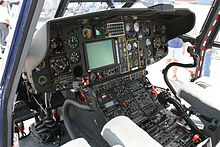
Cockpit of an AS 332 L1 "Super Puma" of the German Federal Police
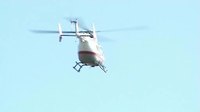
Play media file Flight demonstration with an Airbus Helicopters H145

Speed superimposition on the advancing and retreating blade
Search within the encyclopedia


